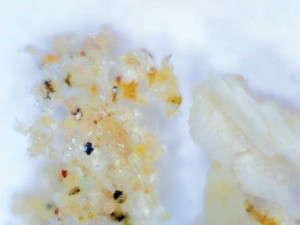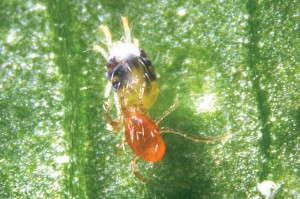D.S. Cole Shares Its Experience Using Predatory Mites

Amblyseius californicus is suitable for situations with a low density of spider mites.
Spider mites are one of the most difficult pests to control in greenhouse operations. They are an annual problem that many growers find difficult to control using cultural and chemical means. Biological agents may be the weapon that allows you to succeed at controlling mites. D.S. Cole Growers has been having great success integrating a predatory mite release schedule with chemical controls to finally get the upper hand in this endless battle.
Biological control of spider mites generally revolves around the release of predatory mites from the family Phytoseiidae, which preys upon insects and other mites. The main advantage of these little hunters is that many species can establish themselves in the crop. They are quite adept at finding mites and consuming them before they become a much larger problem.
Spider mites have several qualities that make them very difficult to control. They feed on the underside of leaves and the action of feeding often causes the leaves to curl downward, creating a protected mite metropolis that is difficult to treat with chemicals. The lifecycle of a spider mite is quite short, which creates many overlapping generations. With multiple life stages at any given time, a chemical that only targets one or two stages (most available chemicals) is unable to eliminate the problem. Another effect of the short lifecycle is the rapid acquisition of resistance.
We Experimented With Predatory Mites To Address A Problem
Frustrated with the increasing challenge of killing mites using chemicals, D.S. Cole Growers took a tip from a skilled grower in Florida and began aggressively releasing predatory mites on several mite-prone crops in July 2013. As an experiment, we released Amblyseius californicus mites onto some tropical plants that had an established spider mite population already. Over the course of about four weeks, the A. californicus mites overtook the spider mite numbers. They were able to find A. californicus mites establishing on the plants and the spider mite population plummeted. By August, the undersides of once-infested leaves were covered with the dry husks of dead spider mites.
After this experiment, we halted pesticide applications and integrated the release of A. californicus mites into the production of cordyline, dracaena, hedera and other mite-prone plants. The grower has not needed to apply a single miticide on these crops since July. Weekly scouting has not located a single mite on these crops.

Phytoseius persimilis is most effective when a mite population already exists. Photo courtesy of Syngenta
Comparing Costs Of Biological Versus Chemical Controls
A frequent question is how much these beneficials cost in comparison to chemical controls. Here is a simple cost comparison between chemical and biological control in a one-acre greenhouse filled with a mite-prone plant. These numbers are for material costs only.
Using a weekly miticide rotation including Pylon, Tetrasan, Sanmite, Akari and Floramite in a one-acre greenhouse would end up costing an average of $150 per application, totaling about $7,800 per year. This is based on using 100 gallons through a hydraulic sprayer. You may use more or less. Some growers may need to use more than one application per week in the spring and summer months.
Using a biweekly (some growers do triweekly or monthly releases) release of 25,000 Amblyseius californicus mites per acre will cost $98 per release, totaling $1,274 annually. A higher release rate of 75,000 A. californicus per acre would cost $294 per release, totaling $3,822 annually. If applied using a blower, the labor used to release is similar to doing a chemical application using a hydraulic sprayer. Beware that buying small quantities of predatory mites is more expensive than these large releases.
How To Get Started With Commonly Used Predatory Mites
The two most commonly used predatory mites for controlling spider mites in greenhouse crops are Amblyseius californicus and Phytoseius persimilis. There are other species available but they tend to be pricier, and for the average greenhouse grower, they have no additional value over the standards.
Phytoseius persimilis is an agile, bright red mite with a voracious hunger for spider mites. Phytoseius persimilis is most effective in situations where a mite population already exists, as they will quickly starve without two-spotted spider mites as prey. This predator multiplies faster than the two-spotted spider mites, and will quickly overtake an infestation. It prefers temperatures between 59°F to 77°F (15°C to 25°C) and a humidity above 60 percent.

Retrofitting a leaf blower to distribute predatory mites in your greenhouse is effective and saves labor.
Amblyseius californicus is a hardy, slower-moving predatory mite. It is more suitable in situations where there is a low density of spider mites. These mites can subsist and reproduce on a variety of food sources, including other arthropods and even pollen. A. californicus is hardier than P. persimilis in temperatures above 77°F (25°C ), as well as in low-humidity environments (less than 60 percent). It is significantly more tolerant of pesticides than P. persimilis, allowing a variety of chemicals to be used without harming the population of predatory mites.
Both mites can be released at rates between 0.5 mites/square foot (preventative) and 3 mites/square foot (heavy pressure, existing mite population). D.S. Cole Growers releases bi-weekly, but others have decreased applications to tri-weekly or monthly.
Our Conclusion: Using Natural Predators Is A Great Option
Predatory mites have been shown to be a competitive alternative to miticide applications in most growing situations. By using these predatory mites as the backbone of your mite control strategy, you can reduce your dependence on chemical controls. In addition, the use of predatory mites offers a benefit for the end consumer because the plants come preloaded with a colony of predatory mites.









